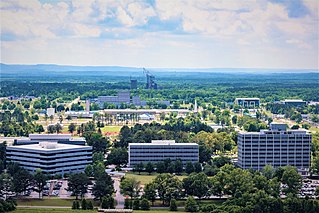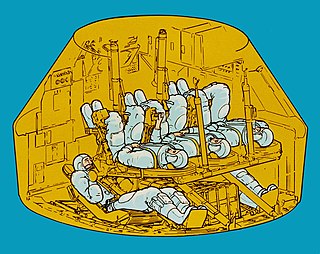
Extravehicular activity (EVA) is any activity done by an astronaut in outer space outside a spacecraft. In the absence of a breathable Earthlike atmosphere, the astronaut is completely reliant on a space suit for environmental support. EVA includes spacewalks and lunar or planetary surface exploration. In a stand-up EVA (SEVA), an astronaut stands through an open hatch but does not fully leave the spacecraft. EVAs have been conducted by the Soviet Union/Russia, the United States, Canada, the European Space Agency and China.

Skylab was the United States' first space station, launched by NASA, occupied for about 24 weeks between May 1973 and February 1974. It was operated by three trios of astronaut crews: Skylab 2, Skylab 3, and Skylab 4. Operations included an orbital workshop, a solar observatory, Earth observation and hundreds of experiments. Skylab's orbit eventually decayed and it disintegrated in the atmosphere on July 11, 1979, scattering debris across the Indian Ocean and Western Australia.

Marshall Space Flight Center, located in Redstone Arsenal, Alabama, is the U.S. government's civilian rocketry and spacecraft propulsion research center. As the largest NASA center, MSFC's first mission was developing the Saturn launch vehicles for the Apollo program. Marshall has been the lead center for the Space Shuttle main propulsion and external tank; payloads and related crew training; International Space Station (ISS) design and assembly; computers, networks, and information management; and the Space Launch System. Located on the Redstone Arsenal near Huntsville, MSFC is named in honor of General of the Army George C. Marshall.

Soyuz 13 was a December, 1973, Soviet crewed space flight, the second test flight of the redesigned Soyuz 7K-T spacecraft that first flew as Soyuz 12. The spacecraft was specially modified to carry the Orion 2 Space Observatory. The flight, crewed by Pyotr Klimuk and Valentin Lebedev, was the Soviet Union's first dedicated science mission, and was the first mission controlled by the new Kaliningrad Mission Control Center.

Skylab 2 was the first crewed mission to Skylab, the first American orbital space station. The mission was launched on an Apollo command and service module by a Saturn IB rocket on May 25, 1973, and carried NASA astronauts Pete Conrad, Joseph P. Kerwin, Paul J. Weitz to the station. The name Skylab 2 also refers to the vehicle used for that mission. The Skylab 2 mission established a twenty-eight-day record for human spaceflight duration. Furthermore, its crew was the first space station occupants ever to return safely to Earth – the only previous space station occupants, the crew of the 1971 Soyuz 11 mission that had crewed the Salyut 1 station for twenty-four days, died upon reentry due to unexpected cabin depressurization.

STS-45 was a 1992 NASA Space Shuttle mission using the Space ShuttleAtlantis. Its almost nine-day scientific mission was with a non-deployable payload of instruments. It was the 46th Space Shuttle mission and the 11th for Atlantis.

STS-56 was a NASA Space Shuttle Discovery mission to perform special experiments. It was Discovery's 16th flight. The mission was launched from Kennedy Space Center, Florida, on April 8, 1993.

STS-95 was a Space Shuttle mission launched from Kennedy Space Center, Florida on 29 October 1998, using the orbiter Discovery. It was the 25th flight of Discovery and the 92nd mission flown since the start of the Space Shuttle program in April 1981. It was a highly publicized mission due to former Project Mercury astronaut and United States Senator John H. Glenn Jr.'s return to space for his second space flight. At age 77, Glenn became the oldest person to go into space, a record that remained unbroken for 23 years until 82-year-old Wally Funk flew on a suborbital flight on Blue Origin NS-16, launching on 20 July 2021, which in turn was broken by William Shatner at age 90 on 13 October 2021 and then by Ed Dwight on May 19 2024. Glenn, however, remains the oldest person to reach Earth orbit. This mission is also noted for inaugurating ATSC HDTV broadcasting in the U.S., with live coast-to-coast coverage of the launch. In another first, Pedro Duque became the first Spaniard in space.

Skylab 3 was the second crewed mission to the first American space station, Skylab. The mission began on July 28, 1973, with the launch of NASA astronauts Alan Bean, Owen Garriott, and Jack Lousma in the Apollo command and service module on the Saturn IB rocket, and lasted 59 days, 11 hours and 9 minutes. A total of 1,084.7 astronaut-utilization hours were tallied by the Skylab 3 crew performing scientific experiments in the areas of medical activities, solar observations, Earth resources, and other experiments.

Karl Gordon Henize was an American astronomer, space scientist, NASA astronaut, and professor at Northwestern University. He was stationed at several observatories around the world, including McCormick Observatory, Lamont–Hussey Observatory, Mount Wilson Observatory, Smithsonian Astrophysical Observatory and Mount Stromlo Observatory (Australia). He was a member of the astronaut support crew for Apollo 15 and Skylab 2, 3, and 4. As a mission specialist on the Spacelab-2 mission (STS-51-F), he flew on Space Shuttle Challenger in July/August 1985. He was awarded the NASA Exceptional Scientific Achievement Medal in 1974.

The Skylab Rescue Mission was an unflown rescue mission, planned as a contingency in the event of astronauts being stranded aboard the American Skylab space station. If flown, it would have used a modified Apollo Command Module that could be launched with a crew of two and return a crew of five.

Skylab 4 was the third crewed Skylab mission and placed the third and final crew aboard the first American space station.
The Apollo Applications Program (AAP) was created as early as 1966 by NASA headquarters to develop science-based human spaceflight missions using hardware developed for the Apollo program. AAP was the ultimate development of a number of official and unofficial Apollo follow-on projects studied at various NASA labs. However, the AAP's ambitious initial plans became an early casualty when the Johnson Administration declined to support it adequately, partly in order to implement its Great Society set of domestic programs while remaining within a $100 billion budget. Thus, Fiscal Year 1967 ultimately allocated $80 million to the AAP, compared to NASA's preliminary estimates of $450 million necessary to fund a full-scale AAP program for that year, with over $1 billion being required for FY 1968. The AAP eventually led to Skylab, which absorbed much of what had been developed under Apollo Applications.

The following outline is provided as an overview of and topical guide to space exploration.

The National Aeronautics and Space Administration is an independent agency of the US federal government responsible for the civil space program, aeronautics research, and space research. Established in 1958, it succeeded the National Advisory Committee for Aeronautics (NACA) to give the US space development effort a distinct civilian orientation, emphasizing peaceful applications in space science. It has since led most of America's space exploration programs, including Project Mercury, Project Gemini, the 1968–1972 Apollo Moon landing missions, the Skylab space station, and the Space Shuttle. Currently, NASA supports the International Space Station (ISS) along with the Commercial Crew Program, and oversees the development of the Orion spacecraft and the Space Launch System for the lunar Artemis program.

The Saturn V is a retired American super heavy-lift launch vehicle developed by NASA under the Apollo program for human exploration of the Moon. The rocket was human-rated, had three stages, and was powered by liquid fuel. Flown from 1967 to 1973, it was used for nine crewed flights to the Moon, and to launch Skylab, the first American space station.

Space research is scientific study carried out in outer space, and by studying outer space. From the use of space technology to the observable universe, space research is a wide research field. Earth science, materials science, biology, medicine, and physics all apply to the space research environment. The term includes scientific payloads at any altitude from deep space to low Earth orbit, extended to include sounding rocket research in the upper atmosphere, and high-altitude balloons.

The Far Ultraviolet Camera/Spectrograph (UVC) was one of the experiments deployed on the lunar surface by the Apollo 16 astronauts. It consisted of a telescope and camera that obtained astronomical images and spectra in the far ultraviolet region of the electromagnetic spectrum.

The Orbiting Astronomical Observatory 2 was the first successful space telescope, launched on December 7, 1968. An Atlas-Centaur rocket launched it into a nearly circular 750-kilometre (470 mi) altitude Earth orbit. Data was collected in ultraviolet on many sources including comets, planets, and galaxies. It had two major instrument sets facing in opposite directions; the Smithsonian Astrophysical Observatory (SAO) and the Wisconsin Experiment Package (WEP). One discovery was large halos of hydrogen gas around comets, and it also observed Nova Serpentis, which was a nova discovered in 1970.

Jack Kinzler was a NASA engineer, the former chief of the Technical Services Center at NASA's Lyndon B. Johnson Space Center, known within the agency as Mr. Fix It. He was awarded the NASA Distinguished Service Medal for creating the solar shield that saved Skylab after the original micrometeoroid shield was lost during launch of the station. His other contributions included the flagstaff and plaques used on the Moon for each of the Apollo program Moon landings and the special six iron golf club head with which Apollo 14 astronaut Alan Shepard made his two famous golf drives on the Moon.





































